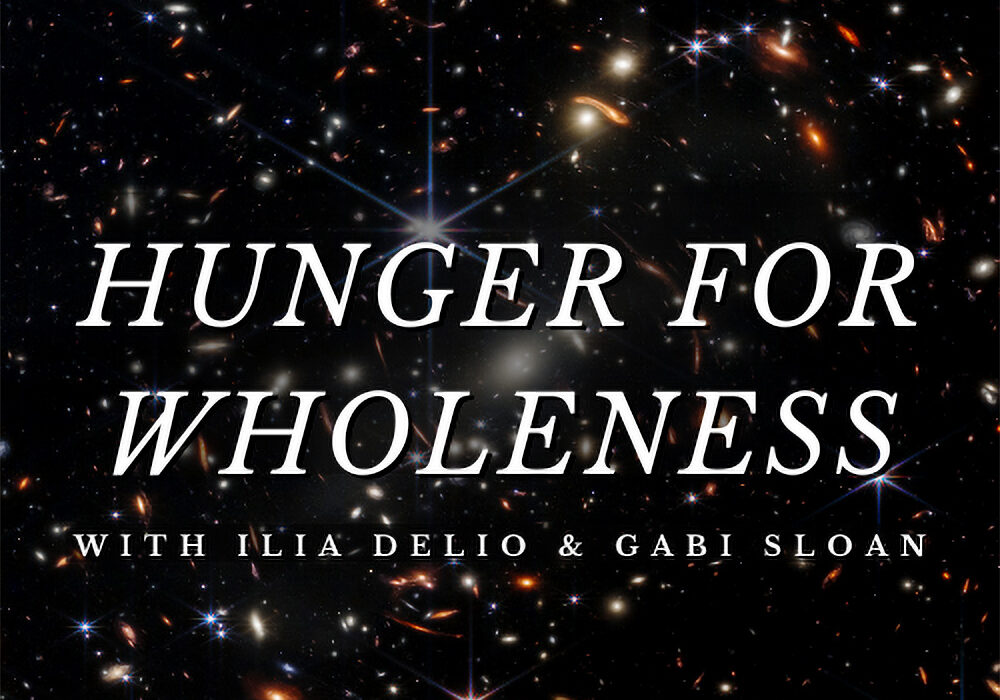One Eye, One Self, One God
Q: Meister Eckhart and Thomas Merton have talked about how the “eye with which you see God is the eye with which he sees you.” In his book “The Experience of God” Raimon Panikkar suggests that our fundamental capacity for awareness, our sentience, equates with the presence of God. Do you understand Eckhart’s idea as a poetic version of Panikkar’s idea about subjective consciousness?
 Ilia: Raimon Panikkar was a Roman Catholic priest and one of the great mystics of the 20th century. The son of a Hindu father and a Spanish Roman Catholic mother, Panikkar wrote of himself: “I left (Europe) as a Christian; found myself a Hindu; and I return as a Buddhist, without having ceased to be a Christian.”[i] Influenced by advaitic (non-dual) Hinduism, Panikkar described the whole of reality as “cosmotheandric,” that is, cosmos, anthropos [human] and God are not three separate realities but the totally integrated vision of the seamless fabric of the entire reality… the undivided consciousness of the totality. This cosmotheandric reality is symbolized by the Christ in whom divinity, humanity and cosmos exist in a unified reality.
Ilia: Raimon Panikkar was a Roman Catholic priest and one of the great mystics of the 20th century. The son of a Hindu father and a Spanish Roman Catholic mother, Panikkar wrote of himself: “I left (Europe) as a Christian; found myself a Hindu; and I return as a Buddhist, without having ceased to be a Christian.”[i] Influenced by advaitic (non-dual) Hinduism, Panikkar described the whole of reality as “cosmotheandric,” that is, cosmos, anthropos [human] and God are not three separate realities but the totally integrated vision of the seamless fabric of the entire reality… the undivided consciousness of the totality. This cosmotheandric reality is symbolized by the Christ in whom divinity, humanity and cosmos exist in a unified reality.
Panikkar lamented that our Christology was too small to meet the needs of our age. His real concern was the disconnection between faith in Christ and the cries of the poor, including planet earth. Most Christians, he said, are apathetic to the problems of the world and are concerned with only their inner political polemics and private problems (married clergy, women priests, etc.). Consumerism dulls the human heart amidst an ecological crisis, while a massive humanitarian crisis of poverty and hunger is ravaging in many parts of the third world. Panikkar points out that many people around the world live in subhuman conditions, thousands of children die every day due to human injustices, wars kill every day, and warring religion is still very much alive. His question, therefore, is what does contemporary Christology have to say about all this? What is the relevance of Christian belief to the burning issues of our times and how does it relate to Christ? “A Christology deaf to the cries of Man,” he writes, “would be incapable of uttering any word of God. . . .Christ is not a divine meteorite.”[ii] Christ is not a postscript to our otherwise comfortable lives. Panikkar states, “if the mystery of Christ is not our very own…it might as well be a museum piece.”[iii]
The title “Christ,” he reminds us, is a Greek name, a translation of the Hebrew word “Messiah” which simply means “anointed.” The generic meaning of the word, “Anointed One,” received a specific meaning within Judaism; the Messiah which the people of Israel expect. The title was individualized in the person of Jesus who was recognized as the revelation of the Christ.[iv] In Christian revelation and through Christian experience, the Christian discovers the Christ. The Incarnation, he states, is not only an historical act in time and space; it is also a cultural event and only intelligible within a particular cultural setting. But the Christian Incarnation is a universal human event, unless we reduce Jesus Christ to a mere historical being.
Panikkar centers Christ in the cosmotheandric Trinity. If we sever Christ from his humanity, he becomes a platonic ideal of perfection, an instrument of dominion and exploitation of others. If we break his humanity from his historical walking on earth and his historical roots, we convert him into a mere Gnostic figure who does not share our concrete and limited human condition. In Jesus, the finite and infinite meet; the human and divine are united; the material and spiritual are one. The humanity of Jesus is our humanity as well. “Jesus is a sign of contradiction,” Panikkar writes, “not because he separates me from others but because he contradicts my hypocrisy, fears, selfishness and makes me vulnerable, like he is.”[v] Whoever sees Jesus Christ sees the prototype of all humanity, the totus homo, the full man—the new Adam.[vi] Jesus Christ is the living symbol of divinity, humanity and the cosmos (material universe) united as one—a “cosmotheandric” symbol.[vii] He asks, “is Christian faith founded on an historical book or a personal experience?” If we answer, “historical book,” then we are talking about a museum piece. If we answer “personal experience” then we have to begin to make sense of Christ in the face of religious pluralism.
If Christ is the central symbol of all reality, according to Panikkar, then in Christ are enclosed not only “all treasures of the divinity but also hidden “all the mysteries of Man” (anthropos) and all the density of the universe. He is not the symbol for reality but the symbol of reality.”[viii] Like Teilhard, Panikkar relies on the Pauline theme: “For in him the whole fullness of divinity dwells bodily” (Col 2:9). Thus he concludes, “Jesus is Christ but Christ cannot be identified completely with Jesus[ix]. . . Christ infinitely surpasses Jesus.[x] Christ is not only the name of a person but the reality of every personal life whether Jew, Muslim, Buddhist or atheist; that is, Christ does not belong only to the Jesus of history but Christ is the Living human Person united with God at the heart of the universe. Thus he points to a deep inner center in the human person with the capacity to manifest Christ, what he calls “Christophany.”[xi]
The term Christophany has as its root, the phaneros of the Christian scriptures: a visible, clear, public manifestation of a truth. “Christophany stands for the disclosure of Christ to human consciousness and the critical reflection upon it”[xii]; each person bears the mystery of Christ within. The first task of every creature, therefore, is to complete and perfect his or her icon of reality,[xiii] since “Christ is not only the name of a historical personage but a reality in our own life” (Phil 2:7-11).[xiv] To know Christ is to discover Christ within. This is where Panikkar and Meister Eckhart cross paths. Eckhart’s famous words: “The eye with which I see God is the same eye with which God sees me” is a Christophanic experience. In one of the last chapters of my new book, Birth of a Dancing Star, I wrote:
The “I” is wrapped up with God, like the double helix of a DNA molecule, in a seamless flow of life, in this dynamic complex of “God-life-my-life,” embedded in the ongoing creativity of cosmic life … Deep within the cave of my heart, a depth that belongs to me alone, I recognize a fire that burns brilliantly and glows with warmth. Through that glowing fire I see the outline of a face, the face of Christ, but I also see my face, and then I began to Christ’s face as my face; and sometimes I cannot tell Christ’s face from my face, and all at once I recognize a single face whose eyes are looking inward and outward. The word “God” simply doesn’t capture this infinite depth of my soul that stretches towards an endless horizon, which by its sheer unlimited being must be divine life because it is life other than my own and yet entangled with my own life. I then began to know that this strange thing called “self” that scientists want to convince me is nothing more than wires and chemicals embedded in a complex informational universe is something more than what can be measured.These wires and chemicals cannot explain my experience of this other-than intimate presence, which is me but not me because—in truth—I simply cannot account for my own existence. How can the configuration of wires and chemicals make a conjugate called “self” when in fact the more I try to know myself in this inward journey, the more I encounter another presence I call God, and the more I travel inward, the more God there is than self and, truthfully, the further I go the less I can speak of either God or self; there is simply an entangled fire of love. In the search for who I am I find God, and in finding God I find my “self” as no separate self but being itself flowing into and out of an unquenchable power of divine love.
The more we enter into the mystical depth of our personal lives, the more we realize there is no “I” apart from a Thou, as the French mystic Simone Weil said, “whoever says ‘I’ lies.” The “I” or the ego is a contraction of self-awareness, a stage in the journey toward the fullness of life. God is mystery and we too exist in that mystery. We are caught up in the “I-Thou” relationship of the Father and Son in such a way that, like Jesus, we too are the “thou” of the Father.[xv] We are entwined in the infinite “Thou-ing” of the divine fountain of love. Every human person manifests Christ because like Christ we are the children of God and thus are part of the divine outpouring of the Father. The Father is the source of my being, the mysterious Fountain of Being, so that everything that I am, including what I define as “mine,” is pure gift. Everything is grace. “Although I am not the ground (of my existence)” Panikkar writes, “neither does that ground exist outside of me. In other words, the ground is not an “other,” a non-I but a “thou” an immanent transcendence in me—which I discover as the “I” of my “I.” I discover myself as “the thou of an I,” (“God is the I, and I am God’s Thou”). This is the genuine experience of Christian advaita or non-dualism (“not one, not two, but both one and two”), preserving both the interpenetration of identity and the reality of personhood. This divine indwelling, the inner fountain of every person’s life, is an invitation to manifest the divine, to become another Christ.”[xvi] Every person is called to live from the inside, the “I-I” interabiding, rooted in our own deepest experience of spiritual seeking and finding. Christ then is no longer an external object of adoration but the deepest reality of every person’s life, indeed, all life.
Panikkar states that the task of Christians today—“perhaps even our kairos—may be the conversion—yes, conversion—of a tribal Christology into a christophany less bound to a single cultural event.”[xvii] By seeing the whole reality in the Christ mystery, he claims, every being is a christophany, “a manifestation of the christic adventure of the whole of reality on its way to the infinite mystery.”[xviii] Christophany is a planetary Christology without dogmas or narrow stipulations; the root reality that binds us together.
Notes
[i] The God language used here belongs to Panikkar. Raimon Panikkar, The Intra-Religious Dialogue (New York: Paulist, 1978), 2. See also Gerard Hall, “Multi-Faith Dialogue in Conversation with Raimon Panikkar,” Paper presented at the Australian Association for the Study of Religions, July 4-6, 2003, p. 2. See https://dlibrary.acu.edu.au/staffhome
[ii]Panikkar, “A Christophany for our Times,” 13 -14.
[iii]Cousins, “Uniting Human, Cosmic and Divine,” 22.
[iv]Panikkar, Christophany, 149; ibid., “A Christophany for our Times,” 7-8.
[v]Panikkar, “A Christophany for our Times,” 15.
[vi]Panikkar, “A Christophany for our Times,” 20.
[vii]For a discussion on Christ as the Cosmotheandric Mystery see Panikkar, Christophany, 180-184; Cheriyan Menacherry, Christ: The Mystery in History A Critical Study on the Christology of Raymond Panikkar (Frankfurt am Main: Peter Lang, 1996), 117 -120; Knitter, No Other Name?, 154 – 156.
[viii]Panikkar, “A Christophany for our Times,” 7; ibid, Christophany, 147. Emphasis added. See also Raimon Panikkar, The Unknown Christ of Hinduism (Maryknoll, N.Y.: Orbis, 1981), 27 where he describes Christ as “a living symbol for the totality of reality: human divine, cosmic” or what he calls the “cosmotheandric reality.”
[ix] Francis D’Sa, preface to Christophany, xvi.
[x]Panikkar, “A Christophany for our Times,” 11. Paul Knitter writes: “Panikkar clearly states that no historical name or form can be the full, final expression of the Christ. Christ, “as the universal symbol for salvation cannot be objectified and thus reified as a merely historical personage.”. . . Panikkar warns against an idolatrous form of historicism in Christianity,” although he does recognize that Jesus is the ultimate form of Christ. See Knitter, No Other Name?, 155-156.
[xi]Panikkar, “A Christophany for our Times,” 5.
[xii]Panikkar, “A Christophany for our Times,” 5.
[xiii]Panikkar, preface to Christophany, xx.
[xiv]Panikkar, Christophany, 21.
[xv]Panikkar, Christophany, xvi.
[xvi]Cousins, “Uniting Human, Cosmic and Divine,” 22.
[xvii]Panikkar, Christophany, 162.
[xviii]Panikkar, Christophany, 146.
 View print-friendly version
View print-friendly version
4 Comments
Related Posts

Hunger for Wholeness Podcast Launches!
Story matters. Our lives are shaped around immersive, powerful stories that thrive at the heart of our religious traditions, scientific inquiries, and cultural landscapes. All stories – big and small…


Wow Sister! What passion in your answer to Meister Eckhart! Your heart is on fire! I will be returning to this deeply beautiful piece again and again. Thank you.
One quote from Panikkar got my attention especially: “Although I am not the ground (of my existence)” Panikkar writes, “neither does that ground exist outside of me. In other words, the ground is not an “other,” a non-I but a “thou” an immanent transcendence in me—which I discover as the “I” of my “I.” I discover myself as “the thou of an I,” (“God is the I, and I am God’s Thou”).
Reminds me of the intimacy of the title of the book and movie, “Call Me By Your Name.”
Thank you for your generous response Ilia. As I continue to read Panikkar it is becoming clearer to me that the path to a deeper understanding/realization of these themes, requires the cultivation of a different way of knowing, which Panikkar sometimes refers to metaphorically as “the third eye”. In the face of paradoxical ideas that defy conventional modes of thinking, this offers a way forward.
Your statement that “Christ does not only belong to the Jesus of history” made my heart leap with joy, resonating a truth of my prayer. I am grateful beyond words for your work